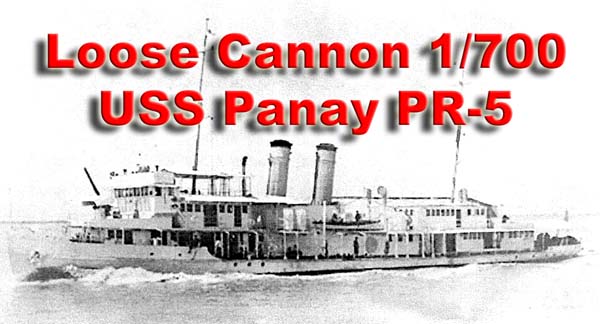
Reviewed August 2017
by Timothy Dike

| The second Panay (PR-5) was built by
Kiangoan Dockyard and Engineering Works, Shanghai, China; launched 10 November
1927; sponsored by Mrs. Ellis S. Stone; and commissioned 10 September 1928,
Lt. Comdr. James Mackey Lewis in command.
Built for duty in the Asiatic Fleet on the Yangtze Patrol, Panay had as her primary mission the protection of American lives and property frequently threatened in the disturbances the 1920s and 30s brought to China struggling to modernize, to create a strong central government, and, later, to meet Japanese aggression. Throughout Panay's service, navigation on the Yangtze was constantly menaced by bandits and soldier outlaws of various stripes, and Panay and her sisters provided the protection necessary for American shipping and nationals, as other foreign forces did for their citizens. Often parties from Panay served as armed guards on American steamers plying the river. In 1931 her commanding officer, Lt. Comdr. R. A. Dyer, reported: "Firing on gunboats and merchant ships have (sic.) become so routine that any vessel traversing the Yangtze River, sails with the expectation of being fired upon." and "Fortunately, the Chinese appear to be rather poor marksmen and the ship has, so far, not sustained any casualties in these engagements." As the Japanese moved through South China, American gunboats evacuated most of the Embassy staff from Nanking during November 1937. Panay was assigned as station ship to guard the remaining Americans and take them off at the last possible moment. They came on board 11 December and Panay moved upriver to avoid becoming involved in the fighting around the doomed capital. Three American merchant tankers sailed with her. The Japanese senior naval commander in Shanghai was informed both before and after the fact of this movement. On 12 December, Japanese naval aircraft were ordered by their Army to attack "any and all ships" in the Yangtze above Nanking. Knowing of the presence of Panay and the merchantmen, the Navy requested verification of the order, which was received before the attack began about 1327 that day and continued until Panay sank at 1554. Three men were killed, 43 sailors and 5 civilian passengers wounded. A formal protest was immediately lodged by the American ambassador. The Japanese government accepted responsibility, but claimed the attack unintentional. A large indemnity was paid 22 April 1938 and the incident officially settled. However, further deterioration of relations between Japan and the United States continued, as did provocations, many of them stemming from the Japanese Army whose extremists wished war with the United States. From: Dictionary of American Naval Fighting Ships
|
|||||||||||
| RESIN PARTS | |||||||||||
| The kit comes cast on a resin wafer along with the superstructure and details. Casting is good and there is a fair amount of detailing. Windows and doors really stand out. Ships boats, davits and the weapons are cast with just a light film of flash. | Click images
to enlarge |
||||||||||
|
|||||||||||
| BRASS BARREL | |||||||||||
| Two CNC machined gun barrels are provided to graft onto the resin main guns. Be careful these parts are tiny and easily lost. |  |
||||||||||
| PHOTO ETCH | |||||||||||
| A simple fret with generic railings and ladder stock is supplied. | |||||||||||
| INSTRUCTIONS | |||||||||||
The instructions are very basic and barely adequate to
build this kit. I would refer to Navsource
and the USSPanay.org website as reference.
|
|||||||||||
| Conclusions: | |||||||||||
 I
aqquired this Loose Cannon kit several years ago in a trade. It appears
to be out of production now, but can still be found from the usual suspects
around the web.While it could use some updating, it should build into a
credible representation of the Panay. I
aqquired this Loose Cannon kit several years ago in a trade. It appears
to be out of production now, but can still be found from the usual suspects
around the web.While it could use some updating, it should build into a
credible representation of the Panay.
It was Kit #37 - 1/700 USS Panay 1937 - LCP West $30.00 based on 2009 pricing. |
|||||||||||
